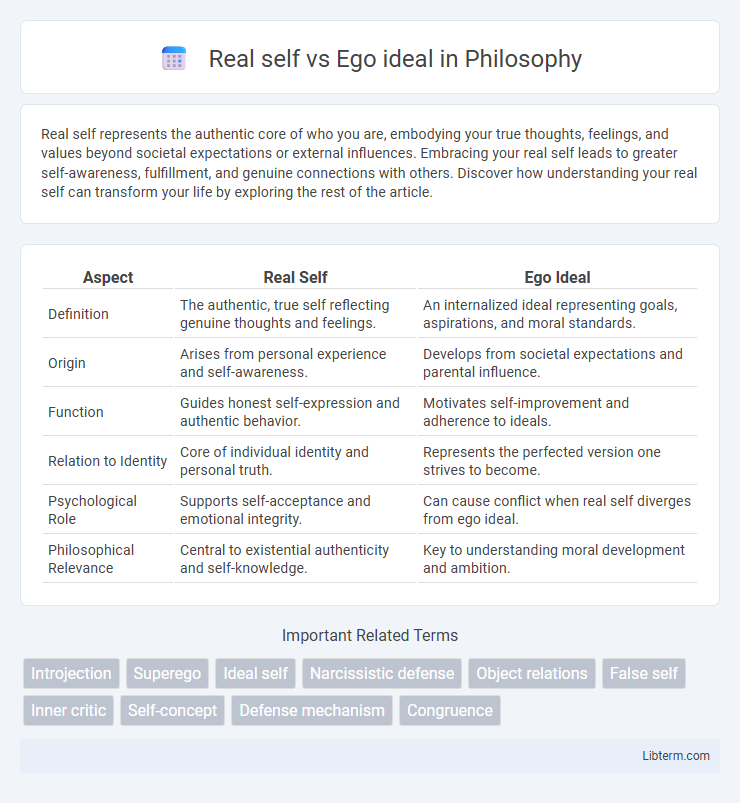Real self represents the authentic core of who you are, embodying your true thoughts, feelings, and values beyond societal expectations or external influences. Embracing your real self leads to greater self-awareness, fulfillment, and genuine connections with others. Discover how understanding your real self can transform your life by exploring the rest of the article.
Table of Comparison
| Aspect | Real Self | Ego Ideal |
|---|---|---|
| Definition | The authentic, true self reflecting genuine thoughts and feelings. | An internalized ideal representing goals, aspirations, and moral standards. |
| Origin | Arises from personal experience and self-awareness. | Develops from societal expectations and parental influence. |
| Function | Guides honest self-expression and authentic behavior. | Motivates self-improvement and adherence to ideals. |
| Relation to Identity | Core of individual identity and personal truth. | Represents the perfected version one strives to become. |
| Psychological Role | Supports self-acceptance and emotional integrity. | Can cause conflict when real self diverges from ego ideal. |
| Philosophical Relevance | Central to existential authenticity and self-knowledge. | Key to understanding moral development and ambition. |
Understanding the Real Self
The real self represents an individual's authentic feelings, desires, and core identity, serving as the foundation for genuine self-expression and emotional well-being. Understanding the real self involves recognizing internal motivations and personal truths beyond external expectations or societal pressures. This awareness fosters psychological resilience, enabling individuals to align actions with true values rather than the unattainable standards imposed by the ego ideal.
Defining the Ego Ideal
The ego ideal represents an internalized set of standards and aspirations derived from parental and societal expectations, guiding an individual's sense of moral and psychological development. It functions as a self-regulatory mechanism that influences behavior by rewarding conformity to these ideals with feelings of pride and self-worth. Distinct from the real self, which embodies authentic personal experiences and traits, the ego ideal shapes one's goals and self-image based on perceived ideals and social norms.
Origins of the Real Self and Ego Ideal
The Real Self originates from authentic experiences, innate drives, and genuine emotions developed in early childhood through secure attachment and unconditioned acceptance. The Ego Ideal forms through internalization of external standards, parental expectations, and societal norms during socialization, serving as a mental image of the ideal self one strives to become. Understanding these origins highlights the dynamic tension between true identity and aspirational self-concepts in psychological development.
The Role of Childhood in Shaping Identity
Childhood experiences significantly influence the formation of the real self and ego ideal, as early interactions with caregivers and social environment establish foundational beliefs and self-perceptions. The real self emerges from authentic desires and feelings developed during these formative years, while the ego ideal reflects internalized standards and expectations imposed by parents and culture. Discrepancies between the real self and ego ideal often trace back to childhood conditioning, impacting identity coherence and psychological well-being.
Real Self vs Ego Ideal: Core Differences
The Real Self represents an individual's authentic feelings, desires, and experiences, while the Ego Ideal embodies internalized societal standards and aspirations. Core differences lie in their functions: the Real Self drives genuine self-expression and personal fulfillment, whereas the Ego Ideal enforces conformity and perfection based on external expectations. Understanding this distinction is essential for psychological well-being, fostering self-acceptance and mitigating inner conflict.
Psychological Impact of Ego Ideal
The ego ideal significantly shapes an individual's self-perception by setting internalized standards of perfection derived from caregivers and society. This psychological construct influences motivation, self-esteem, and feelings of guilt when personal behavior falls short of these ideals. Persistent discrepancies between the real self and the ego ideal can lead to anxiety, diminished self-worth, and contribute to the development of neurotic symptoms.
The Struggle Between Authenticity and Aspirations
The real self embodies an individual's genuine feelings, desires, and identity, while the ego ideal represents societal standards and personal aspirations shaped by external expectations. This tension creates an ongoing struggle between maintaining authenticity and pursuing ideals that often demand conformity or perfection. Balancing these forces is crucial for psychological well-being, as excessive dominance of the ego ideal can suppress true self-expression and lead to inner conflict.
How Social Influences Shape the Ego Ideal
The ego ideal is dynamically shaped by social influences such as cultural norms, family expectations, and peer feedback, which establish internalized standards for self-worth and behavior. These external social factors contribute to the contrast between the real self--the authentic individual experience--and the ego ideal, which represents the aspirational self one strives to achieve. Continuous social interactions reinforce or challenge the ego ideal, impacting self-concept and personal development over time.
Healing the Divide: Integrating Real Self and Ego Ideal
Healing the divide between the real self and ego ideal involves cultivating self-awareness and acceptance to reconcile authentic identity with aspirational goals. Integrating these aspects reduces internal conflict and promotes psychological wellness by aligning self-perception with realistic and compassionate standards. Therapeutic approaches such as cognitive-behavioral therapy and mindfulness practices facilitate this integration by fostering self-compassion and adaptive self-reflection.
Steps Toward Authentic Self-Acceptance
Real self represents an individual's true feelings, desires, and values, while the ego ideal reflects internalized societal and parental expectations. Steps toward authentic self-acceptance involve recognizing and differentiating between these constructs, embracing personal strengths and vulnerabilities, and gradually reducing dependency on external validation. Cultivating mindfulness and self-compassion facilitates alignment with the real self, promoting emotional resilience and genuine confidence.
Real self Infographic

 libterm.com
libterm.com